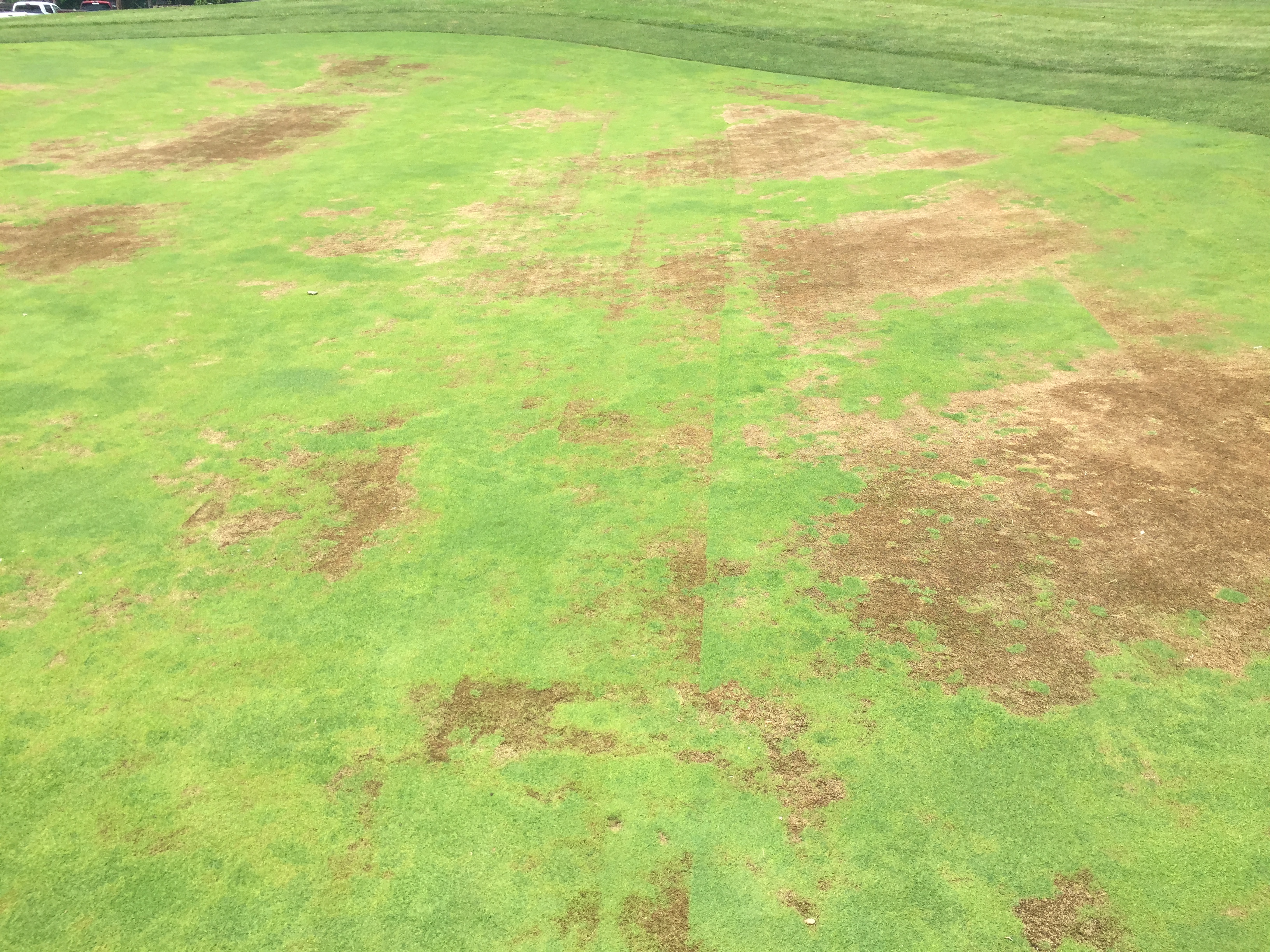Wet Weather and Diseases Create Problems on Pennsylvania Golf Courses
June 17, 2018 in Articles
Submitted by Pete Landschoot
Abnormal temperatures and frequent rains during the spring of 2018 have led to mowing injury and disease problems on Pennsylvania golf courses. The worst of the problems began to occur in central and western PA during late May, when daytime temperatures climbed into the 80’s and night temperatures were in in the mid to high 60’s.
Mowing is always a challenge when turf is wet and soils are saturated, but when coupled with rapid late-spring growth, the result can be scalping injury on putting greens. One of the worst cases I observed was on a course where the membership requested the superintendent curtail his spring aeration and topdressing practices. Towards the end of May, the bentgrass became puffy and was severely scalped when mowed under wet conditions.

Mower injury on bentgrass putting green.
Diseases are always an issue this time of year, but timely fungicide applications and good cultural practices typically keep damage to a minimum. This year’s abnormal spring weather ushered in some unusual disease problems, some of which we are still trying to diagnose.
Two diseases that showed up on putting greens and fairways in May and early June in central PA were Microdochium patch (formerly called Fusarium patch) and leaf spot. Typically, Microdochium patch produces distinct circular pink or reddish-brown patches, about 3 to 6 inches in diameter, during periods of wet weather in May. The pink or red color comes from fungal fruiting structures called sporodochia, which give rise to millions of microscopic slightly curved spores called conidia. Conidia are spread from plant-to-plant by water, mowers, or golf shoes. The pathogen of Microdochium patch, Microdochium nivale, is the same pathogen that causes pink snow mold. The difference between these diseases is that Microdochium patch does not occur under snow cover, and usually occurs in late spring. Microdochium patch can cause disease on bentgrasses, but is more common on P. annua. A number of fungicides are labeled for control of Microdochium patch, including azoxystrobin and azoxystrobin combination products (Headway, Strobe T, and others); Concert II (chlorothalonil + propiconazole); Instrata (chlorothalonil + propiconazole + fludioxonil); Fame+T (fluoxastrobin + tebuconazole); Interface (iprodione + trifloxystrobin); and others.

Symptoms of Microdochium patch on a putting green, and close up of individual patch on P. annua.

Symptoms of Microdochium patch on a putting green, and close up of individual patch on P. annua.
Leaf spot is a disease of bentgrass greens and fairways. It often shows up as circular or irregular reddish-brown patches of varying sizes during periods of persistent, light rain in May and June. Spots on individual leaves have red or reddish-brown borders, and can be observed with a good-quality hand lens or dissecting microscope. As the disease progresses, spots coalesce and develop into blighting of entire leaves and stems. Although the cigar-shaped spores of the pathogen(s), Bipolaris or Dreschlera spp., are easy to identify using a microscope in a diagnostic lab, they are too small to be observed in the field. Many different fungicides can be used to control leaf spot diseases, including those containing iprodione, chlorothalonil, and the strobilurins.

Leaf spot symptoms on bentgrass fairway in central PA.
During early June, several golf courses in the Pittsburgh area experienced damage on P. annua putting greens and fairways from one or more root and crown diseases. Root/crown diseases are difficult to diagnose because fungal pathogen structures used for identification are not easily observed in root tissue, more than one fungus may be present in the roots, and some fungi on or in roots revert to pathogenic activities only when plants are under environmental or cultural stress. Despite these issues, disease outbreaks were diagnosed as a Pythium root disease and/or summer patch. The fact that root diseases are occurring this early in the season reflects the unusual weather conditions experienced in May and early June. In the case of root/crown diseases, fungicides are most effective when applied prior to symptom expression. Disease symptoms may continue to develop when fungicides are applied after the disease becomes apparent.

This disease of P. annua on a putting green in western PA was diagnosed as summer patch.